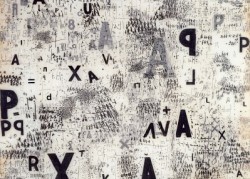A great retrospective exhibition of the enigmatic Mira Schendel (1919-1988) arrives at São Paulo’s Pinacoteca after opening with great commotion in September last year at the Tate Modern in London, crowning the bridge between both cities which started in 1966 when Mira showed her work at Signals gallery. This is the first monographic international show of the artist who is a very important part of the development of European Modernism in Brazil. It is very interesting to see how she adapted and created her own language. The exhibition brings more than 250 pieces among paintings, drawings and installations, some never exhibited before.
Fairly unknown to the international public and still a lot to be publicized to Brazilians, she makes this connection in her work, which has profound European roots. Born in Switzerland in 1919, Mira immigrated to Brazil in 1939 as a Jewish fleeing from the Nazi and arriving in Porto Alegre, where she began her career as an artist. Later she moved to São Paulo and participated on the first Biennial there in 1951. Then she married Knut Schendel, German, owner of Canuto’s bookshop, and became part of the intellectual circle of the capital. Mira spent her nights absorbed in deep philosophical conversations that are reflected in her works.
Even though she was surrounded by predominant artistic movements of the time, like Constructivism and Neoconcretism, Mira does not get fixed into any stile determination. Her abstract forms bear deep meanings that go beyond formalism. They float between the abstract and figurative and stay on the tangent, touching everything at the same time. Her oeuvre is hard to decipher at a first glance, but by knowing her intentions it gets easier to understand. Inculcated of existential theories, she tries to understand the relation between man and world. Mira aims to go beyond reason through abstraction, but at the same time maintains a point of identification with the spectator through figuration. Her works have a non-temporal and universal openness that is capable of bearing an imminent and transcendental content at the same time.
She is able to translate philosophical concepts into material symbols in an enchanting way. The exhibition opens with “Still Life” from 1953 with which she participated in the first São Paulo Biennial. During the 60s she begins to make geometrical paintings, but without following a Euclidean geometry because they are not symmetrical. Basic forms like circles, triangles and squares make part of this metaphysical universal language. Mira plays with space in a reference to Phenomenology. Simple objects like a chair or a spoon gain a surprising corporeity through weight, contrast and comparing.
Her mystical and enigmatic compositions are transforming. The texture and materiality of her “Landscapes” (1963) approximate her to European art informel. But her arquetypical forms reaffirms her interest on the relation between being and the void, the unity of all. The spiral as a graphic element represents space/time. To put yourself before Mira’s paintings is to be transported into a non-rational dimension where nothing comes to your mind and you experiment the void.
The letters presented on the “Monotypes” series, with more than 2,000 drawings made on rice paper are like readymades for the creation of a visual poetry. They don’t have a literary meaning, but are codes to a non-conventional language, open and universal, a silence that says it all. Without worrying much about technical maestri, more through the force of simplicity, she can transpose the essence of existence.
With the same rice paper she created the series “Droguinhas” or “Little Drugs, sculptures made of the entangled paper and that together with her “Embroideries” relate to a more domestic and feminine production and references Zen philosophy by the simplicity of the task. The characteristic of transparency of the rice paper was a great finding for Mira who was studying the Philosophy of Jean Gebser at the time. For him, transparency is a form of spiritual manifestation that is in all things and that permits a transformation of consciousness. We see the evolution of Mira in this sense in what follows of the exhibition in a reproduction of the installation “Graphic Objects” created for the 1968 Venice Biennale. The viewer walks along the pieces that can be seen from one side or the other.
With “Little Train” which she took to London for the exhibition at Signals gallery, “Transformables”, the beautiful “Perforated” and the kinetic series “Discs” we follow on the transparency theme so fruitful for her career. Until we reach the installation “Still Waves of Probability” which she presented at the 1969 São Paulo Biennial. When many artists stated a boycott to the institution during Brazil’s dictatorship, Mira participated to show there are other ways of resisting. Influenced by Gebser she used transparent lines to demonstrate that there are things we don’t see but are a great part of our lives, occult forces, like faith.
The immateriality of the material, the visibility of the invisible. This installation and “Variables” are the highpoint of the exhibition. Many pieces of transparent paper hanging with engraved codes, cryptographic, but with no need to be deciphered to be understood. Very well assembled, with a magnitude and at the same time an admirable delicacy, to reveal the force of Mira to express transcendence.
The exhibition finalizes with her works from the 80s, referencing the dynamics of opposing forces from the I Ching and her last series from 1987 “Battens”, an explosion of basic forms, not contained in the determined space, recreated in the perfect harmony of her compositions. Mira managed to unite all her language to generate a modification in human consciousness through presence. Only standing by her works already provokes a transformation. The show at São Paulo’s Pinacoteca will be a unique opportunity for Brazilians to participate in this changing experience of Mira Schendel’s art.



